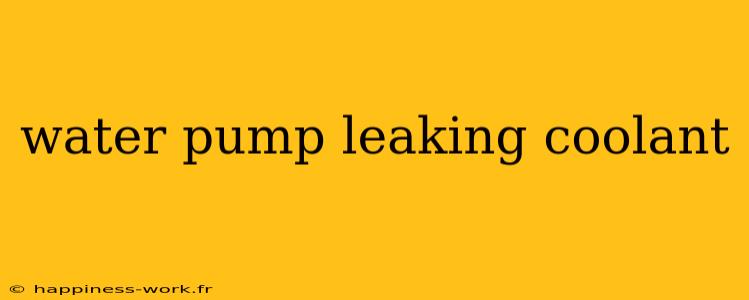Water pump leaks can be a significant concern for vehicle owners, often leading to severe engine problems if not addressed promptly. In this article, we will explore common causes of coolant leaks from water pumps, symptoms to watch for, and practical solutions to keep your engine running smoothly.
What is a Water Pump?
A water pump is a crucial component of your vehicle's cooling system. It circulates coolant throughout the engine to dissipate heat and maintain optimal operating temperatures. When a water pump starts leaking coolant, it can lead to overheating and, if left untreated, can severely damage the engine.
Common Causes of Water Pump Leaks
-
Worn Seals and Gaskets
Over time, the seals and gaskets around the water pump can degrade due to heat and pressure, leading to leaks. -
Corrosion
If the coolant isn't changed regularly, it can become corrosive, eating away at the metal components of the water pump. -
Cracks in the Pump Housing
Physical damage or corrosion can cause cracks in the water pump housing, leading to coolant leaks. -
Improper Installation
If the water pump was recently replaced and not installed correctly, it can lead to leaks due to misalignment or insufficient sealing. -
Hoses and Connections
Sometimes, the leak may not be from the pump itself but from loose or damaged hoses and connections in the cooling system.
Symptoms of a Leaking Water Pump
Identifying the symptoms of a leaking water pump early can prevent further damage to your vehicle. Here are some signs to watch for:
-
Puddles of Coolant
Finding green, orange, or pink fluid under your vehicle can indicate a coolant leak. -
Overheating Engine
If the engine temperature rises beyond the normal range, it may suggest insufficient coolant circulation due to a leak. -
Unusual Noises
A grinding or whining noise from the water pump area could indicate a failing pump. -
Coolant Warning Light
If your vehicle’s dashboard shows a warning light for low coolant, it may be linked to a leak.
Solutions for Water Pump Leaks
Short-term Fixes
-
Add Coolant
If you notice the coolant level is low, temporarily topping it off can help you get back on the road. However, this is only a short-term solution. -
Sealant Additives
There are sealant products available that can be added to the coolant to help seal minor leaks. While this may help temporarily, it is essential to address the underlying issue.
Long-term Fixes
-
Replace the Water Pump
If the pump is leaking, it may need to be replaced. This is especially true if there are signs of corrosion or significant wear. -
Check Hoses and Connections
Inspect all hoses connected to the cooling system. Replacing worn-out hoses can often fix the leak without needing to replace the pump. -
Regular Maintenance
Ensure that the coolant is changed per your vehicle manufacturer’s recommendations. Regular maintenance can prevent corrosion and extend the life of your water pump. -
Professional Inspection
If you are unsure about the source of the leak or lack the necessary tools, it is wise to consult a professional mechanic. They can provide a thorough inspection and recommend the best course of action.
Conclusion
A leaking water pump can lead to severe engine problems, but being aware of the symptoms and causes allows you to take proactive measures. Regular vehicle maintenance and prompt attention to leaks can help ensure your vehicle remains in optimal condition.
For more detailed insights and instructions on diagnosing and fixing coolant leaks, consider visiting WikiHow for additional resources.
Attribution: This article integrates information from WikiHow's knowledgeable authors on the topic of water pumps and coolant leaks.
Remember, taking care of your vehicle's cooling system is essential for its longevity and performance. Stay vigilant, and don’t ignore those warning signs!
